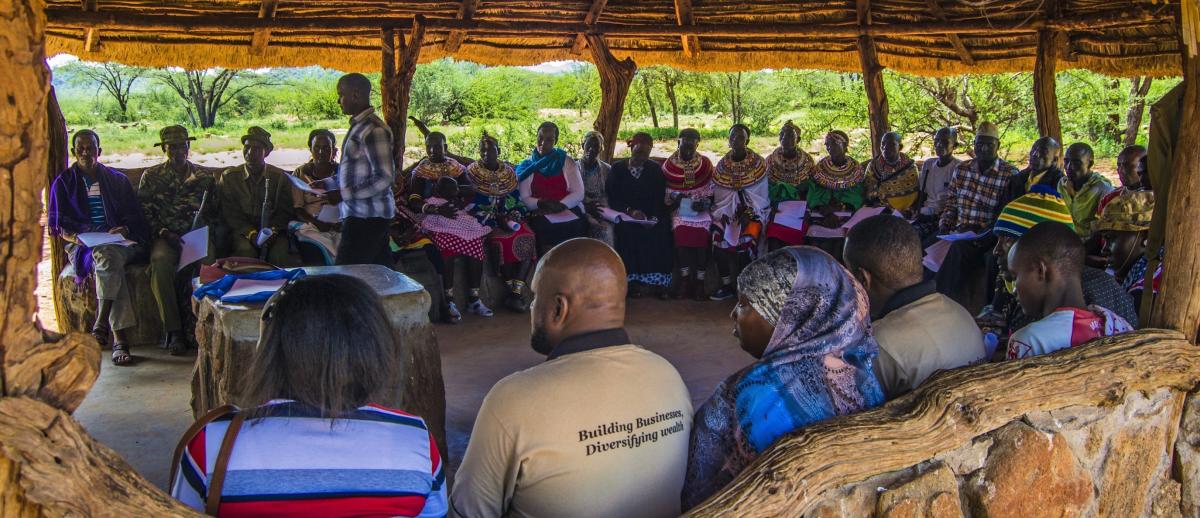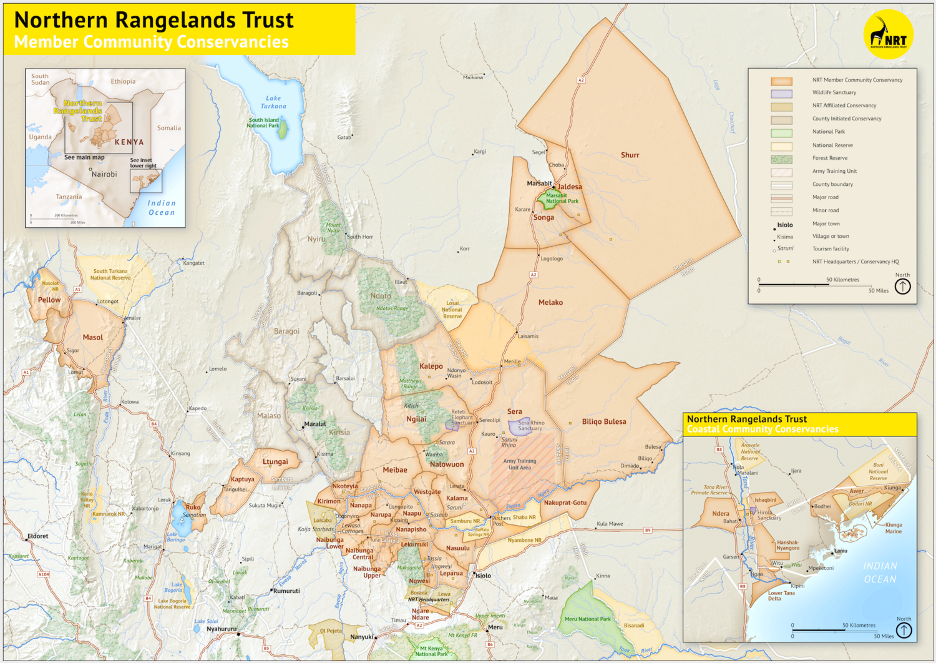Who’s In, Who’s Out? Challenges for Conservation Partnerships in Sub-Saharan Africa
archive


A stakeholders meeting at one of the Northern Rangelands Trust conservancies. (Photo credit: Duncan Ndotono)
Who’s In, Who’s Out? Challenges for Conservation Partnerships in Sub-Saharan Africa
The devolution of management rights over wildlife outside protected areas in Kenya and elsewhere in Africa has given rise to collaborative wildlife management, opening an avenue for the formation of partnerships that include various international conservation NGOs. Partnership as a concept is often used to refer to a voluntary process by which partners impartially share functions, rights, and responsibilities for the conservation of a protected area, whether public, private, or communal, as well as its related resources (Borini-Feyerabend and Sandwith, 2003). In wildlife conservation and management, the partnership approach is based on collaboration (Mburu and Birner, 2007), and understanding the challenges experienced by each partnering stakeholder is a prerequisite for conservation success. While partnership is a good concept that can bring many benefits to local stakeholders, there is a need to reflect upon the positions of the communities, the conservancies, and the international NGOs that are supposed to be at the core of such conservation initiatives.
Using the Samburu East sub-county in Kenya as a case study, I found the community and their respective conservancies discontented with their partnership arrangements. There is a body of literature on partnerships in wildlife conservation and management across sub-Saharan Africa which includes studies on Kenya (e.g. Sumba et al. 2007; Lamers et al. 2014), but a knowledge gap exists on the dynamics of conservation partnerships in Samburu County. Therefore, to characterize the challenges faced by conservation partnerships in the study area and to aid institutional performance, I collected data for seven months in 2018, relying on key informant interviews, focus group discussions, secondary data sources, and observations of fieldwork conditions. The study site included four conservancies under the umbrella of the Northern Rangelands Trust (NRT), namely Namunyak Wildlife Conservation Trust, Meibae Community Wildlife Conservancy, Westgate Community Wildlife Conservancy and Kalama Community Wildlife Conservancy) as shown in the map in Figure 1. The conservancies studied have partnerships with different stakeholders as described in Appendix 1.
Challenges
The various challenges I identified fall under six themes: the role of international organizations in conservation, disillusionment of the local community, the conservancy’s position and role in conservation, conservancy-investor relations, lack of proper coordination among stakeholders, and the conflict-prone status of northern Kenya. I discuss these challenges below.
Various international non-governmental organizations (INGOs) such as Conservation International, Tusk Trust, USAID, San Diego Zoo, and the Nature Conservancy are involved in conservation in the study area of the Northern Rangelands Trust (NRT). Some of the INGOs, such as the Nature Conservancy, have been regarded as having questionable motives (Mbaria and Ogada, 2016). Globally, such organizations, often called “conservation elites”, enhance capitalism by advancing a narrative of privatization, commodification, and marketization of nature, thereby selling nature to save it from market forces yet culminating in alienation of native populations from their lands and disruption of their livelihoods (Holmes, 2011; 2012; 2018). According to a key informant, INGOs roles are often not fully embedded in conservation but in other interests that consume money and time without producing a long-lasting impact. This leads to a donor-dependency syndrome amongst the conservancies, thereby creating a perception in the community that conservation is a white-man driven initiative.
The sense of project ‘ownership’ by the community is often lacking due to inadequate understanding of the conservancy concept. Two key challenges identified by key informants are (i) the burden of sharing resources pooled to a common fund among all conservancies under the umbrella of the NRT, including those without investors such as Meibae; and (ii) questions surrounding who the real beneficiaries are, since the NRT and the conservancies have taken too long to achieve the goals envisioned when the conservancy model was adopted. Furthermore, it was reported that Kenya’s Wildlife Conservation and Management Act (2013) had never been fully operationalized due to the lack of follow-through on compensation resulting from human-wildlife conflicts. Some community members believe that research organizations such as Action for Cheetahs in Kenya, Save The Elephants, and Ewaso Lions seek to increase populations of species that heighten human-wildlife conflicts or retaliatory killings.

Figure 1: A map showing the Northern Rangelands Trust conservancies including those studied.
Additionally, cost-benefit sharing among the partners has accelerated disillusionment within the community as revenue generated by the conservancies is not fully disclosed. For instance, income from sand harvesting was not revealed to community members, leading to suspicion and mistrust in the conservancies’ management boards. Such disillusionment spans the southern rangelands of Kenya (Kirigia and Riamit, 2018).
Despite the Trust executing its stated functions, the Samburu community faults the NRT for not being flexible in power-sharing and for focusing on expansion of the conservancies’ membership under its umbrella, rather than the sustainability of the existing conservancies. The legitimacy, motives, and operations of the Trust are controversial (Mbaria and Ogada, 2016; Bersaglio, 2017; Fox, 2018), and its growth and influence is a result of the State’s pulling back from direct involvement in biodiversity conservation and its rolling out of new mechanisms and structures that permitted markets to play a key role in biodiversity conservation (Mbembe, 2001; Castree, 2008).
“We could have been very far in terms of self-sustenance as a conservancy only if the investor regularly reviewed the terms of agreement and paid us well.” These were sentiments from focus group discussions that highlight the nature of partnership agreements between conservancies and their respective investors. It emerged that the agreements were not based on mutual respect for all stakeholders, as some felt entitled or superior. For instance, in 2018 there was an incident involving the Kalama Conservancy in which mistreatment of locals by the manager of the Saruni Lodge was reported. Other forms of harassment and threats against native employees by foreign managers were also reported in Namunyak.
INGOs roles are often not fully embedded in conservation but in other interests that consume money and time without producing a long-lasting impact.
Furthermore, and despite the Samburu County support of conservation and livelihoods enhancement, there is a lack of proper coordination among stakeholders in the study area. For instance, when it comes to livestock production and management, the county operates a breeding stock program in which it purchases livestock for the community without their consultation on desired breeds and type. In one case, purchased camels are not adaptable to local prevailing conditions and died during drought seasons, which is why the community had desired different animals such as goats. Furthermore, the community has regularly pointed out the county’s inability to follow up on the implementation of previous projects. For instance, a water project that the Samburu County government funded in the previous year’s budget was dysfunctional because the contractor used substandard pipes that had burst, and no one made the effort to see that the fault was addressed. Some key informants cited the county government’s failure to adhere to conservancies’ respective land use plans when implementing development projects. Examples include the indiscriminate drilling of boreholes and the construction of Early Childhood Centres in Westgate. Other stakeholders also often overlooked pre-existing conditions and at times duplicated projects.
[C]ost-benefit sharing among the partners has accelerated disillusionment within the community as revenue generated by the conservancies is not fully disclosed.
Finally, competition over natural resources among various groups are rampant and often lead to conflict in the drylands of East Africa (Reda, 2015). A key informant at the KWS Isiolo-Samburu complex revealed how the availability of guns and their possession by locals renders it difficult for their security personnel to differentiate between poachers and herders. Moreover, community revenge missions launched between the Turkanas and Samburus over cattle rustling, grazing resources, and water access along the Ewaso Nyiro River were rampant.
Conclusion
Partnerships aimed at enhancing the resilience of pastoral and agropastoral households faced with changes in their ecosystems are on the increase, but they are not devoid of other kinds of challenges (Lugusa et al., 2016). The challenges, as highlighted in this brief study, curtail stakeholders’ attainment of set objectives. The commodification, privatization, and marketization of nature opened an avenue for the collaboration of communities, governments, local organizations, and INGOs. Some stakeholders committed to conservation initiatives do so out of goodwill and through their funding they have enabled the Northern Rangelands Trust to grow in scale and influence, but there are others whose intentions are questionable. Whereas it can be said that all stakeholders aim to enhance biodiversity conservation and the well-being of communities like the Samburu, it is often very difficult to attain coordination, respect, trust, and transparency among partners given the heterogeneity or complexity of their objectives. However, mechanisms enhancing these virtues, if explored in conjunction with making the communities and their respective conservancies the core of the conservation initiative, can enhance the success of the partnership approach to conservation. It is also imperative for the communities themselves to take charge in ensuring that peace prevails, as it is a prerequisite for the advancement of development, conservation, and livelihoods in northern Kenya and beyond.
Appendix 1
A collection of lands and communal holdings unified under a single management plan to collectively enhance conservation and natural resource use.
| Conservancy | Group Ranches | Investors | Partners |
| Namunyak (Nalowuon, Kalepo & Ngilai units) Formation Year: 1995 Area (hectares): 383,804 |
Sarara, Sabache, Ngilai west, Ngilai central, Ngare-Narok, Ndonyowasin | Sarara and Kitich camps. | NRT, Kenya Wildlife Service (KWS), Kenya Police Service (KPS), Kenya Forest Service (KFS), The Nature Conservancy (TNC), Save The Elephants (STE), Tusk Trust, The United States Agency for International Development (USAID), Conservation International, San Diego Zoo, Samburu county government (SCG), other conservancies, local community. |
| Kalama Formation Year: 2002 Area (hectares): 49,660 |
GirGir | Old Boma Limited (Saruni lodge) | SCG, NRT, Grevy’s Zebra Trust (GZT), SNR, STE, Ewaso Lions, KPS, local community, other conservancies. |
| Westgate Formation Year: 2004 Area (hectares): 36,230 |
Ngutuk Ongiron | Tamimi Company Limited (Sasaab lodge) | SCG, NRT, GZT, KPS, SNR, STE, Ewaso Lions, SAFE Samburu, other conservancies, local community. |
| Meibae Formation Year: 2006 Area (hectares): 101,517 |
Sesia, Ltirimin, Lpus, Ngaroni | None | SCG, NRT, Action for Cheetahs in Kenya (ACK), KWS, KPS, Ewaso Lions, other conservancies, local community. |
Bersaglio, B. (2017). Green grabbing and the contested nature of belonging in Laikipia, Kenya: A genealogy (Doctoral dissertation), Department of Geography, University of Toronto, Canada.
Borrini-Feyerabend, G., and Sandwith, T. (2003). “From guns and fences to paternalism to partnerships: the slow disentangling of Africa’s protected areas.” Conservation partnerships in Africa, 13(1), 1-5.
Castree, N. (2008). “Neoliberalising nature: the logics of deregulation and reregulation.” Environment and Planning A, 40(1), 131-152.
Holmes, G. (2011). “Conservation's friends in high places: Neoliberalism, networks, and the transnational conservation elite.” Global Environmental Politics, 11(4), 1-21.
Holmes, G. (2012). “Biodiversity for billionaires: capitalism, conservation and the role of philanthropy in saving/selling nature.” Development and Change, 43(1), 185-203.
Holmes, G. (2018). “Conservation Jujutsu, or how conservation NGOs use market forces to save nature from markets in Southern Chile.” In The Anthropology of Conservation NGOs (pp. 181-201). Palgrave Macmillan, Cham., pp. 181-201.
Kirigia, K., and Riamit, K. (2018). “Land Injustices in Kenya’s Wildlife Conservancies.” Tourism and Development in Africa. global-e, Vol. 11, Issue 50. Available at:
https://www.21global.ucsb.edu/global-e/october-2018/land-injustices-keny...
Mbaria, J., and Ogada, M. (2016). The big conservation lie: the untold story of wildlife conservation in Kenya. Lens and Pens Publishing LLC, Aurburn WA, USA.
Lugusa, K. O., Wasonga, O. V., Elhadi, Y. A., and Crane, T. A. (2016). “Value chain analysis of grass seeds in the drylands of Baringo County, Kenya: A producers’ perspective.” Pastoralism, 6(1), 6.
Mbembe, A. (2001). On the post-colony (Vol. 41). University of California Press.
Mburu, J., and Birner, R. (2007). “Emergence, adoption, and implementation of collaborative wildlife management or wildlife partnerships in Kenya: A look at conditions for success.” Society and Natural Resources, 20(5), 379-395.
Reda, K. T. (2015). “Natural resource degradation and conflict in the East African pastoral drylands: Is blaming the victim a solution?” African Security Review, 24(3), 270-278.
Sumba, D., Warinwa, F., Lenaiyasa, P., and Muruthi, P. (2007). “The Koija Starbeds ecolodge: A case study of a conservation enterprise in Kenya.” African Wildlife Foundation Working Papers (October 2007). Nairobi: African Wildlife Foundation.



